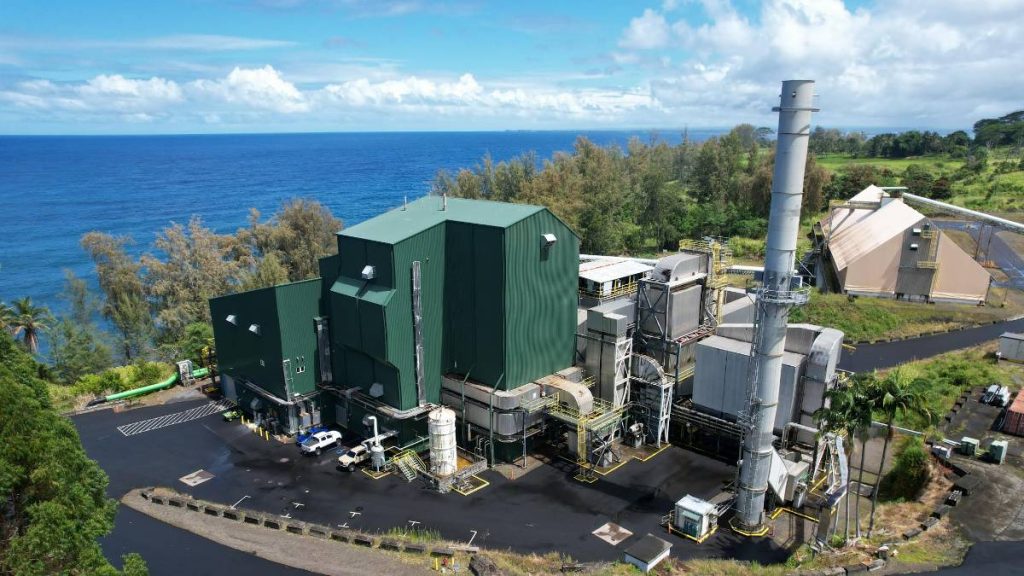Big Island energy plant working on agreement with Hawaiian Electric to sell its power

Honua Ola Bioenergy on Hawai‘i Island and Hawaiian Electric are in the midst of negotiations on an agreement in which the plant will sell energy and capacity to the utility.
A joint letter submitted to the state’s Public Utilities Commission and filed on June 3 informed the commissioners that Hawaiian Electric received an offer from Hu Honua, which owns Honua Ola Bioenergy, to sell energy and capacity by Hu Honua as a qualified facility under the Public Utility Regulatory Policies Act of 1978, also known as PURPA.
This federal law is designed to encourage energy conservation, efficient use of energy resources and development of renewable energy sources. It does this by obliging electric utilities to purchase electricity from qualifying facilities that meet certain criteria.
This letter comes less than a month after Honua Ola Bioenergy filed a lawsuit in 1st Circuit Court on O‘ahu seeking relief from anticompetitive and other unlawful conduct designed to foreclose competition and restrain trade in the wholesale market for firm power generation (power that is guaranteed to be available at all times, even during adverse conditions).
Joint Letter to PUC From Hu Honua Bioenergy and Hawaiian Electric by Tiffany De Masters on Scribd
The lawsuit against Hawaiian Electric, the state’s largest power supplier, claims the company has created a monopoly that has resulted in the renewable energy plant being unable to operate. The next hearing on the matter is scheduled for Aug. 12.
It is unclear how these negotiations will affect the impending lawsuit.
Honua Ola Bioenergy is a new 30 megawatt firm, renewable biomass facility located in Pepe‘ekeo. When operating, it would generate renewable and sustainable energy by using locally produced biomass feedstock from eucalyptus crops and invasive species. The plant would also create more than 220 direct and ancillary jobs in the greater Hilo community, the company said.
The June 3 letter indicates the facility is already constructed, essentially complete and ready for commissioning in short order.
According to a fact sheet from Hu Honua, enough renewable energy would be produced to power more than 19,500 homes, which also supports wind and solar by stabilizing the grid, delivering nearly 20% of Hawai‘i Island’s power.
Documents filed with the state’s Public Utilities Commission indicate the two companies have made substantial progress and have reached a power purchasing agreement in principle on the major terms. The parties are now working on completing all of the components to implement the agreement.
The documents don’t outline the terms of this agreement.
The commission responded to the letter on June 23 stating that “given the current uncertainty around global supply chain- and tariff-related issues, as well as the age of the original IRS (Interconnection Requirements Study) for this project,” the Commission advises the two parties to file the power purchasing agreement and any associated waiver request with the Commission when the study update is complete and final.
The parties are in the process of conducting an updated study, which was originally done in 2010.
“Honua Ola continues to pursue all available paths to starting operations at its renewable energy facility, which will provide reliable and affordable energy for Hawaiʻi Island’s ratepayers,” said Warren Lee, president of Hu Honua.
He said starting operations at the plant will reduce Hawaiʻi Island’s reliance on imported fossil fuels and help shield residents and businesses from spikes in oil prices that drive volatility in monthly energy bills.
“Adding a new source of always-available, reliable energy will bolster the grid and help avoid rolling power blackouts, while affordably achieving the state’s clean energy goals,” Lee said.
Honua Ola’s facility also will reduce greenhouse gas emissions compared to the island’s fossil fuel-powered facilities, he said.
The company also is committed to growing and planting trees and other crops that sequester greenhouse gas.
Hawaiian Electric declined to provide further comment on the matter, citing its policy not to discuss ongoing negotiations.
Hawaiian Electric first entered into an agreement with Hu Honua in May 2012 for the generation and sale of electricity from the power plant.
Application for the agreement was initially approved by the state with Hawaiian Electric emphasizing that Hu Honua would help “reduce HECO’s reliance on fossil fuels” and “increase its overall renewable energy portfolio.”
Hawaiian Electric ultimately terminated the agreement because Hu Honua missed certain contractual milestones, according to the May lawsuit documents.











